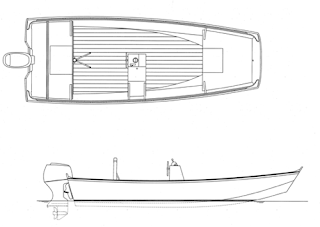"Grub" is a flat bottomed camp-aboard skiff derived from Phil Bolger's Clam Skiff.
Grub is 21' long and 5'7" at the waterline, with 6" of rocker beginning at @ 8' from the bow. It is flat bottomed with a 1 3/4" x 16" V keel running the length of the hull. Adding the keel did great things for running in a chop. I love the boat, and my wife and I go out to the mooring in the evening almost every week in the summer if the weather allows, have a drink sitting on the stern, eat dinner, and sleep aboard, just for the pleasure of it.
Nantucket harbor can develop a sea when the wind blows from the Southwest, with a four mile stretch of open water. You can get an idea of how your boat behaves in larger waves and confused seas. Thinking that some day we might want to make some longer trips, say to Martha's Vineyard, or beyond to Long Island Sound, NYC and the Hudson River, I began to think that the slab sides of Grub were perhaps not well suited to rougher water.
Dave Lucas of Tiki Hut fame was a short while ago effusing about the merits of a garvey being built at his place, the Big Ben from Doug Hylan. I sent for plans, with the idea of taking my whole cabin set-up out of Grub and setting it in the new hull. I wrote Doug and proposed the idea of traveling some sea distance in Big Ben, and he wrote back that as long as you slowed down in rough water, Big Ben would be up to the task. He also described it as "corky", which really got my attention.
I got as far as laying out the bulkheads on the shop floor. I realized that the measurement of the stern, at the waterline, was nearly identical to Grub. And, Grub was a little longer boat. There were only two real differences in the two boats apart from the bow shape. Ben had a slight v-bottom, and Ben had flare.
Well then. The new keel on Grub mimicked a lot the behavior of a v-bottom, so it's flare that might make a difference. Would it be crazy to add flare to Grub?
I put a 6" wide gunwale on Grub when I built it, to give a walkway and to catch spray which was a problem in my previous build, Grinder.
So, if I added 4 1/2" to the gunwale, and connected the gunwale to the waterline, I would have the same flare as Ben, and a lot of other seaworthy boats, including dories. This drawing from the Glen-L Dragonfly:
OK! Would it be worth the trouble? Would it add a lot of weight? How do you go about adding flare to a boat?
First I glued a batten on the existing gunwale, 3/8" lower than the top. Then I added pieces 3/8" thick 4 1/2" inch wide to the gunwale, and added a 3/4" stringer along the new gunwale.
The natural extension of the battens past the previous bow resulted in the new bow shape and the new stem. The stem was a lot of cutting and fitting and discarding and starting again.
I settled on 1/4" Okume for the side panels, in 2' sections, with 1 1/2" wide 3/8" thick battens in between the panels. I glued angled stringers to the hull bottom that would allow the side panels to just touch the old hull.
The detail at the motorboard was complex. Really helpful is the trick of dabbing circles of glass at corners to get a smooth waterproof edge.
I trial fit all the panels, cut them roughly to size, and worked my way along the boat. Here is the almost completed new hull.
To reattach the cleats, and to get at the space between the new and old hulls, I added hatch plates on the bow, sides and stern. When the panels were all attached but before the stern panels were on, I poured new epoxy in the bow hatch and let it run all the way to the stern to seal the hull to panel joint. I covered the new hull with 6 oz. glass, and painted with acrylic.
Here is the finished product. The new hull added 96 lbs. to Grub, offset by removing some ballast from the bow. Grub seems very different now in rough water, a little drier, more "corky", more controllable, more fun. I think it is prettier too.
I'll be trading in the 30 HP Tohatsu for a 50 this Fall. My hope is that more power at the slow speeds I favor will give an even quieter ride, and better maneuverability when I need it.













